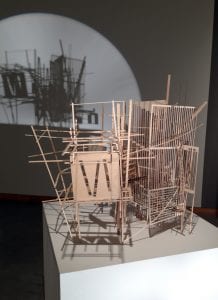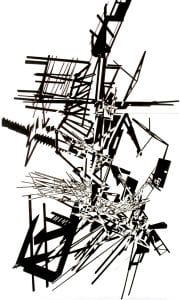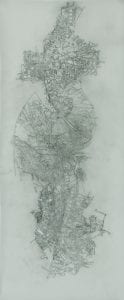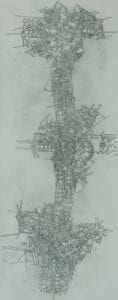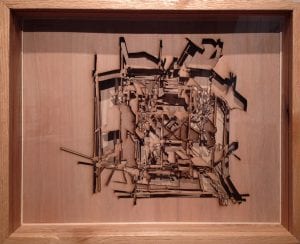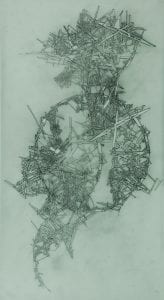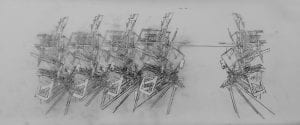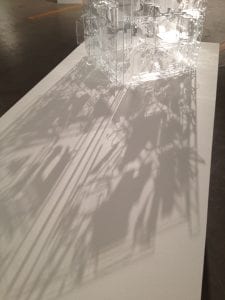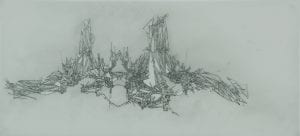
- This event has passed.
ANTHONY VISCARDI Tracing Time to Measure Space
August 28, 2013 - December 8, 2013

Foreword by Ricardo Viera, Professor of Art A|A|D, Director/Curator, LUAG
Lehigh University Art Galleries – Museum Operation (LUAG) is very pleased to present Anthony Viscardi: Tracing Time To Measure Space – New Drawings and Constructions an art/architectural exhibition of the ideas and works of Lehigh University Professor Anthony Viscardi.
For over 20 years, the practice of tracing shadows has informed the architectural scholarship and “pedagogy of form” in Viscardi’s inquiry into creative design theory and his application to the studio/classroom as an integrated experimental arena. His creative as well as inspirational drawings/constructions, derived from the direct observation of the passage of light over time, navigate a conceptual landscape between two- and three-dimensional space.
Viscardi is a nationally and internationally recognized authority for his search/research comprised of scholarship, creative work and classroom methodology. He continues to inspire students and scholars, alike. His aim is not only to teach the perception of design but rather to impart the creative design process. This exhibition has been designed as an open-classroom where classes, guided tours, and visitors-at-large will experience a new concept in the “art” of architecture.
Lehigh University Art Galleries – Museum Operation (LUAG)’s central educational resource is viewed as a multifaceted integrated classroom in which education is approached in the following ways: Museum and Curatorial Studies; Collections Care and Management; Exhibitions and Interpretation; and Partnership with the
Community. Courses are taught across-the-disciplines using the University’s world-class teaching collection, which represents a diverse and broad cross-section of art and culture. Students and faculty have direct experiential learning within the Integrated Teaching Collection and Visual Laboratory. Exhibitions are specifically
planned to function as teaching tools exploring diverse topics in visual literacy and the humanities.
As a university museum, LUAG has been a well-established, evolutionary and progressive program within the broader institutional mandate of the University. Our educational and cultural mission is advanced through firsthand observation and hands-on training. Students develop skills to respond critically to a changing world through problem-based learning and collaboration, ultimately preparing them to become well-informed consumers of visual culture in the broadest sense.
Mediating Between Realities
Essay by Danielle Rago
Liberating architecture from the practical constraints of building, American artist Anthony Viscardi examines the space between art and architecture through explorations of solid/void, presence/absence, static/dynamic, and material/ephemeral continuums. Using drawing, a practice common to both art and architecture, Viscardi employs Rapidograph, ink wash, and graphite to reveal intricately detailed examinations of shadow and void. These shadow mappings have been the basis of the artist’s twenty-year practice and pedagogy, and most recently, are the subject of this compelling exhibition Tracing Time to Measure Space which articulates the artist’s process through drawings and three-dimensional constructions.
Generated from time-based interactions during three periodic intervals of day —morning, noon and night — the ephemeral play of shadows is made static through sequential tracings that collapse space and time into one singular composite drawing. The resultant drawings, referred to by the artist as primitives, visually map the process that is both the basis for Viscardi’s practice and the subject matter of his work.
Viscardi’s process is derived from traditional architectural drawing methods that privilege the hand and eye. While contemporary architectural practice has indeed shifted from handcraft to digital design, the process by which external factors (formulas rather than light) affect or influence the built form is still prevalent today. In this way, Viscardi’s practice is very much relevant to contemporary discourse while also remaining true to the craft of handmade fabrication with its attention to detail.
This intimate process of drawing as a multisensory and intuitive experience is fundamental to all of Viscardi’s work. The drawings in this exhibition result from the collusion of phenomena: the physicality of the object casting a shadow, the quality of light in real time and space, and the negotiation between the materials and the artist’s hand.
The shadow functions as the progenitor of form, albeit with some mediation. A three-dimensional model, conceived as a mechanism to produce shadows, is constructed in dialogue with the drawing. At times, the drawing is overlaid with a nine-square grid, similar to the latitudinal and longitudinal lines of a map, to better navigate the movement of the sun and the object’s cast shadow. This model is transient, like the shadows themselves. It is used solely for the production of the drawing and then often dismantled, leaving the visual record of the mapping process behind. In addition to providing a record of how an object interacted with light at a particular place and time, these shadow mappings establish a visual matrix from which further iterations of three-dimensional form are derived.
No longer separate entities, the object and shadow merge within the space of Viscardi’s drawings. This inseparability of structure and light is at work throughout this series of shadow mappings. Viscardi’s visual investigations posit architecture as a proactive medium by which to enact change in the built landscape. They are also part of his teaching pedagogy. Trained as an architect and now also practicing as an artist, Viscardi delves into many visual and conceptual realms. His work draws conceptual parallels to Italian architectural masters Carlo Scarpa and Renzo Piano through its strategic interplay of shadow and light. At the same time, Viscardi’s drawing style revisits and extends the visionary forms of the late American architect Lebbeus Woods, as well as Daniel Libeskind’s, Micromegas, a complex and meticulously constructed series of drawings which offer a critical reinterpretation of traditional architectural space. Viscardi’s work also has strong similarities to American artist Stephen Talasnik’s practice. From Talasnik’s free-form pencil and ink drawings to his tensile sculptures, the works are similar in scope, informed visually by the language of architecture. By exploring the interdependency of drawing and sculpture both Viscardi and Talasnik’s visionary drawings and objects produce expansive environments that invite the viewer into the space of imagination.
The drawings vary in scale from small projections in large fields, to larger works with a smaller field of vision. The small projections are reminiscent of urban design projects where one can imagine vertical planes and horizontal lines rising to organize habitable spaces within a cityscape. The larger works offer a telescopic projection of a more expansive field or perhaps a microscopic view of an art-object. These drawings effectively liberate the idea of architecture from its professional constraints to allow for a different perspective on making, one that is independent of digital equations and computer-driven aesthetics, and unencumbered by the practical considerations of translating from two dimensions to three-dimensional space. Released from its formal contract with the object, the shadow now has an independent life and functions as the mediator between the realms of the real and imagined, static and dynamic, visible and invisible. The phenomenological qualities of light and the effects it produces through the shadow become the elusive generators of form and ultimately the structure or organizing principle for three-dimensional invention. Here, illumination and architecture engage in a codependent way through which both are equally expressed and neither ignored.
Danielle Rago, a former student of Viscardi, is an independent curator living and working in New York City and Los Angeles. She is also a freelance contributor to a number of international publications on art, architecture, and design. She has worked with the Metropolitan Museum of Art and the Guggenheim Museum in New York and the A+D Museum and MAK Center in Los Angeles, and published in Abitare, The Architect?s Newspaper, Architectural Record, CLOG, Domus, LOG: Observations on Contemporary Architecture and the City, PIN-UP Magazine, and WIRED. Danielle holds a Master?s degree in Architecture History and Critical Thinking from the Architectural Association, London. Her focus is on the shifting role of the institution and media, and how contemporary architecture and its public are being produced and mediated through the institution and curator.
